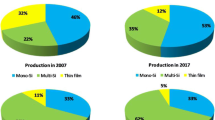Abstract
In this research article, Taguchi L18 orthogonal array has been employed on guarded heat plate apparatus to determine ‘unit heat loss rate’ (U value) of a double-glazed window with inter-pane venetian blinds by varying processes and glazing system’s parameters, i.e. temperature difference between hot and cold plates, low-emissivity (low-e) coating and its location, slat angle of blinds, pane spacing and hot plate temperature (selected as per composite climate in India). The analyses of the raw data and signal-to-noise (S/N) ratio of the response parameters have been performed using analysis of variance (ANOVA). The insignificance of temperature of hot plate has been reiterated. The optimum parameters predicted on the basis of analyses of S/N ratio (pooled ANOVA) are (a) temperature difference of 10 °C, (b) presence of low-e coating on inner surface of outside pane, (c) slat angle of 90° and (d) pane spacing of 32 mm. The quantification of the influence of various parameters on U value has been done through prediction of percentage contribution. The significant parameters in order of their decreasing percentage contribution are presence of low-e coating (49.2 %), slat angle (32.52 %), temperature difference between hot and cold plates (8.76 %) and pane spacing (4.33 %), respectively.





Similar content being viewed by others
References
Arasteh, D., Reilly, S., Rubin, M. (1989). A versatile procedure for calculating heat transfer through windows. ASHRAE Transactions, 95(2).
ASHRAE (2009). “Fenestrations.” In ASHRAE Handbook—Fundamentals (SI). Atlanta, GA: American society of heating, refrigeration and air-condition engineers Inc, Chapter15.
ASTM. (2006). E1423–06 Standard practice for determining steady state thermal transmittance of fenestration systems. Pennsylvania: ASTM International.
Baker, J. A., Sullivan, H., & Wright, J. L. (1989). Study of pane spacing in glazing system (pp. 262–272). Penticton: Solar Energy Society of Canada.
Branz Ltd. Porirua, New Zealand. (2013). Passive Design. (BRANZ Ltd) Retrieved November 13, 2013, from Level: The authority on Sustainable buildings: http://www.level.org.nz/passive-design/glazing-and-glazing-units/glazing-options-for-temperature-control/.
Curcija, D. (2000). Trends and developments in window testing methods. Lithuania: Baltic Window Conference.
Elsherbiny, S., Raithby, G. D., & Hollands, K. (1982). Heat transfer by natural convection across vertical and inclined air layers. Journal of Heat Transfer, 104, 96–102.
Erhorn, H., Stricker, R., Szerman, M. (1987). Test methods for steady-state thermal transmission. In IEA-Annex XII - Windows and Fenestration, Report (pp. 1–27 (3.3.2)). Delft: Energy Conservation in Buildings & Community Systems Programme Step 2.
Fisher, R. (2006). Statistical methods for research workers. New Delhi: Cosmo Publications.
Garnet, J. M., Fraser, R. A., Sullivan, H. F., & Wright, J. L. (1995). Effect of internal venetian blinds on window centre-glass U values (pp. 273–295). Toronto: Window Innovations.
Goyal, T., Walia, R. S., & Sidhu, T. S. (2012). Study of coating thickness of cold spray process using Taguchi method. Materials and Manufacturing Processes, 27(2), 185–192. doi:10.1080/10426914.2011.564249.
Huang, N., Wright, J., & Collins, M. (2006). Thermal resistance of a window with an enclosed venetian blind: guarded heater plate measurements. ASHRAE Transactions, 112(2), 13–21.
ISO. (2003). ISO 15099:2003, thermal performance of windows, doors and shading devices—detailed calculations. Geneva: ISO.
Kacker, R. N., Lagergren, E. S., & Filliben, J. J. (1991). Taguchi’s orthogonal arrays are classical designs of experiments. Journal of Research of the National Institute of Standards and Technology, 96(5), 577–591.
Kumar, V., & Gakkhar, R. P. (2012). Noise, emissions and fuel economy investigation on a small DI diesel engine working on jatropha bio-diesel, using Taguchi methods. Torino: ASME 2012 Internal Combustion Engine Division, Spring Technical Conference.
Phadke, M. S. (1989). Quality engineering using robust design. Prentice Hall.
Rheault, S., & Bilgen, E. (1989). Heat transfer analysis in an automated venetian blind window system. Journal of Solar Energy Engineering, 111, 89–95.
Ross, P. J. (1988). Taguchi techniques for quality engineering. New York: McGraw Hill Book Company.
Roy, R. K. (2010). A Primer on the Taguchi Method. Society of Manufacturing Engineers.
Sharda, A., & Kumar, S. (2014). Statistical evaluation of U value of a window with inter-pane blinds. International Journal of Ambient Energy. doi:10.1080/01430750.2014.977496.
Singh, J., Walia, R. S., Satsangi, P. S., & Singh, V. P. (2011). Parametric optimization of hybrid electric discharge machining process with continuous and discontinuous ultrasonic vibrations on workpiece. International Journal of Materials Science and Engineering, 2(1–2), 47–53.
Stamatis, D. (2002). Six sigma and beyond: design for six sigma. CRC Press.
Taguchi, G. (1988). Introduction to quality engineering: designing quality into products and processes. Am. Supplier Inst.
Timberlake, Kieran Projectwell. (2011). Indian concept house: a white paper on manufacturing and assembling of an affordable, quick-to-build and sustainable mass housing solution for Indian cities. Gurgaon: RICS India.
Wright, J. S. (1987a). Simulation and measurement of windows with low emissivity coatings used in conjunction with teflon inner glazings (Vol. 4, pp. 3136–3140). Hamburg: ISES Solar World Congress.
Wright, J. S. (1987b). Simulation and measurement of windows with metal films used in conjunction with teflon inner glazings (Vol. 4, pp. 5–12). Lausanne: International Conference on Building Energy Management.
Wright, J., & Sullivan, H. (1988). Glazing system U value measurement using a guarded heater plate apparatus. ASHRAE Transactions, 94(2), 1325–1337.
Wright, J., Collins, M., & Huang, N. (2008). Thermal resistance of a window with an enclosed venetian blind: a simplified model. ASHRAE Transactions, 114(1), 471–482.
Yahoda, D. S., & Wright, J. L. (2004). Heat transfer analysis of a between-panes venetian blind using effective longwave radiative properties. ASHRAE Transactions, 110(1), 455–462.
Author information
Authors and Affiliations
Corresponding author
Rights and permissions
About this article
Cite this article
Sharda, A., Kumar, S. Experimental investigation of U value of double-glazed window with inter-pane blinds using Taguchi techniques. Energy Efficiency 9, 1145–1161 (2016). https://doi.org/10.1007/s12053-015-9413-8
Received:
Accepted:
Published:
Issue Date:
DOI: https://doi.org/10.1007/s12053-015-9413-8




